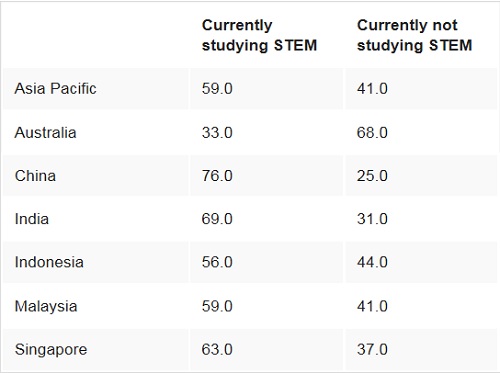Girls in STEM careers: It’s on you, parents!
By Digital News Asia March 9, 2016
- Parents are crucial influencers for girls pursuing STEM careers: MasterCard study
- Australia has lowest percentage of girls studying STEM, China the highest

THE key to attracting girls in Asia Pacific to study STEM (science, technology, engineering and mathematics) subjects and pursue STEM-related careers lies with families, according to MasterCard’s inaugural Girls in Tech research.
The results are based on interviews that took place in December 2015 with 1,560 girls aged 12-19 across six markets in Asia Pacific: Australia, China, India, Indonesia, Malaysia and Singapore.
When asked about influences on their decision to study STEM subjects or pursue STEM as a career, girls in the region overwhelmingly rated parents as the most influential (68%), with peers (9%) and teachers (8%) as the next biggest sources of influence, MasterCard said in a statement.
The survey also found that more than half (63%) of the respondents currently studying STEM subjects at school had parents and/ or elder siblings in STEM-related fields, showing that family members’ career choice has a significant influence.
In understanding why girls in the region are not considering pursuing STEM subjects in their studies, the survey revealed that the top reasons were that they found these subjects difficult (40%) and had a lack of interest in the subjects (32%).
Among the countries surveyed, Australia had the lowest percentage of girls (15-19 years old) who were studying STEM (33%), while China (76%) and India (69%) topped the cohort in terms of uptake of STEM subjects.
In addition, the survey found that while girls recognise that STEM as a career is financially and intellectually satisfying, they perceive STEM subjects and careers as not being ‘creative.’
About 84% of the respondents felt that creativity was a personal trait or skill that they found extremely desirable to have, yet when asked what traits they associate with girls in STEM, less than half (43%) felt girls in STEM have this quality.
Profiling successful women in STEM as role models continued to resonate with girls (17-19 years old) who considered this an effective means of encouraging them to consider STEM careers (25%), while targeted scholarships (17%) and salary in STEM careers (16%) were also listed as being helpful in encouraging girls to strongly consider STEM careers.

“Existing data tells us that girls are consistently underrepresented in the STEM fields, and MasterCard’s inaugural Girls in Tech research aims to answer the question ‘why’,” said Georgette Tan, Communications group head, Asia Pacific, MasterCard.
“The pursuit of STEM offers some of the world’s best opportunities to be involved in cutting-edge innovation and technology, and encouraging more women in these fields is key to better economic success and equality for all women.
“To get more girls interested in STEM, we need to promote female role models and parents must help to build the confidence of their children.
“We must correct the misconception that STEM careers can’t be creative and help build that next generation of women leaders in STEM,” she added.
In 2014, MasterCard launched Girls4Tech, an education programme that showcases MasterCard’s payment technology and engages employees as role models and mentors, in a bid to encourage more girls to pursue STEM-related subjects or careers.
In Asia Pacific, Girls4Tech has been launched in Australia and India, and will be rolled out to the rest of the region, the company said.
Related Stories:
10 women behind key technology breakthroughs
The gender gap in STEM
Women in the workplace: Asia is just the worst
For more technology news and the latest updates, follow us on Twitter, LinkedIn or Like us on Facebook.


